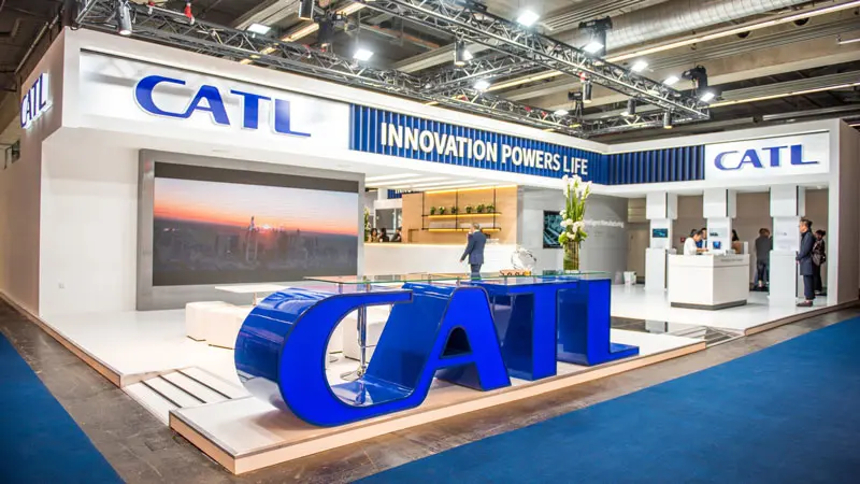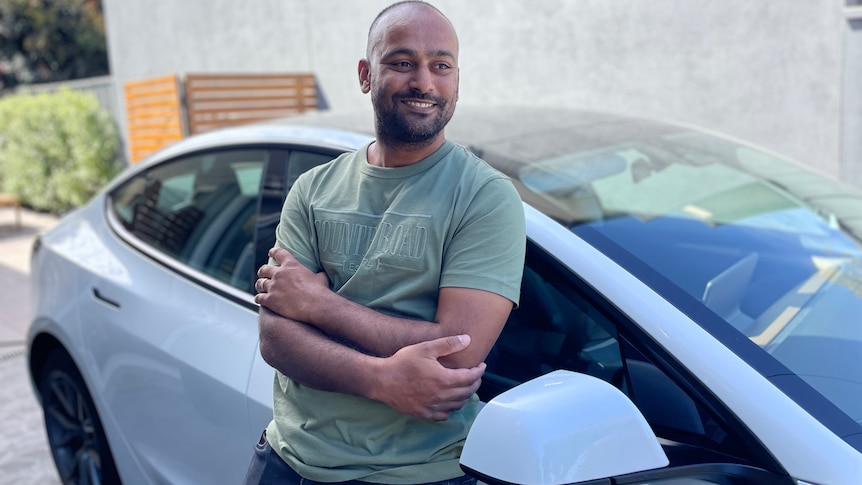Interesting. I was talking about building factories for manufacturing. That would get around current tariffs. They bought an old Ford plant in Brazil. How long before this happens in Mexico? Evidently, not long according to this article from a couple of weeks ago.
EV developments
- Thread starter begreen
- Start date
-
Active since 1995, Hearth.com is THE place on the internet for free information and advice about wood stoves, pellet stoves and other energy saving equipment.
We strive to provide opinions, articles, discussions and history related to Hearth Products and in a more general sense, energy issues.
We promote the EFFICIENT, RESPONSIBLE, CLEAN and SAFE use of all fuels, whether renewable or fossil.
You are using an out of date browser. It may not display this or other websites correctly.
You should upgrade or use an alternative browser.
You should upgrade or use an alternative browser.
EbS-P
Minister of Fire
I wonder what this will do to the US EV market.
Even quotes Tony Seba

 cleantechnica.com
cleantechnica.com
Even quotes Tony Seba

CATL, BYD To Slash Battery Prices By 50% In 2024. BOOM! EVs Win! - CleanTechnica
CATL says it will begin selling LFP battery cells in the VDA format at price less than $60 per kWh hour by the middle of this year.
 cleantechnica.com
cleantechnica.com
Wow, that's a disrupter. So much for technical advantages of pouches. Money talks, nobody walks.I wonder what this will do to the US EV market.
Even quotes Tony Seba

CATL, BYD To Slash Battery Prices By 50% In 2024. BOOM! EVs Win! - CleanTechnica
CATL says it will begin selling LFP battery cells in the VDA format at price less than $60 per kWh hour by the middle of this year.cleantechnica.com
"GM began by using pouch cells for its much ballyhooed Ultium batteries but has now changed horses in midstream and switched to cylindrical cells."
I wonder what this will do to the US EV market.
Even quotes Tony Seba

CATL, BYD To Slash Battery Prices By 50% In 2024. BOOM! EVs Win! - CleanTechnica
CATL says it will begin selling LFP battery cells in the VDA format at price less than $60 per kWh hour by the middle of this year.cleantechnica.com
EXACTLY. All those battery plants that GM and Ford are building? Can they compete with this?
Of course not. GM and Ford will need to retool/replan those factories to make the next generation of LFP batteries either themselves or in partnership with an innovative battery company, or to at least buy CATL cells.
This is a fancy way of saying their current battery tech and product lines are stranded and not commercially viable (i.e. profitable). So GM and Ford will pick themselves up, dust themselves off, and start making products with the new battery chemistry. And have a little smoke and mirrors (PR) for investors about how no one wants EVs (LOL). Then when they field the next generation of EVs they will say 'Oh, folks DO want EVs now, so we made some.'
The $64000 question is whether that NEXT generation of Ford and GM EVs will also be stranded in the same way by a battery innovation in 2025?
TL;DR: Ford and GM recently stepped on a rake, and are now staggering around in a daze. Whether they find their footing, or just step on another rake next year remains to be seen.
EbS-P
Minister of Fire
How many different battery cells is Tesla using right now? I think 4. I could be wrong. (S and X get one type, MY and M3 get three. I might have missed one).
I do think this was part of Ultium’s plan but…. The reality is you do have to commit to where your getting the batteries from and in what qualities early (years??) in the design process. What quantities have already been contracted?
Timing is super important.
I do think this was part of Ultium’s plan but…. The reality is you do have to commit to where your getting the batteries from and in what qualities early (years??) in the design process. What quantities have already been contracted?
Timing is super important.
Its a good PR tactic to get elected but tariffs rarely work in the long term as the other side retaliates. with tariffs of their own.
EbS-P
Minister of Fire
Soy beans and pork. My bigger worry would be export tariffs on batteries.Does China import much from the USA?
One EV that seems to be be left out of the conversation is the Aptera. Rightfully so as the basic design goes back to a 2005 design that ended up going defunct. The original owners bought the rights and redesigned it as an EV with solar panels on the roof and claimed at one point that it would never need charging. It is still a 3 wheel design to get around safety standards. Production is always "right around the corner" but they seem to real good at the publicity game. I dont see them ever being a player.
ABMax24
Minister of Fire
How many billions of dollars in tax payer money has the US government handed out to reshore microchip manufacturing so as to not rely on a foreign nation about to be taken over (peacefully or by force) by it's largest geopolitical adversary? Seems tariffs are cheap in comparison.
At best offshoring more US manufacturing to China is a bad idea.
At best offshoring more US manufacturing to China is a bad idea.
One might say that in the past decade, mostly manufacturing jobs.Does China import much from the USA?
EbS-P
Minister of Fire
Cost parity by 2027. And manufacturing costs drop faster than batteries! That’s huge. What remains to be seen is what models the traditional automakers will have available in 2026-2028. If you don’t have giga castings lines by then you are in trouble. It does mention increasing repair costs. But who hasn’t seen that already. Shop rates for my local shop are $135 / hr and Tesla is $205/hr.
But the more vehicles that get written off as a total loss he more used parts and batteries on the market. That has some upside.
But the more vehicles that get written off as a total loss he more used parts and batteries on the market. That has some upside.
How much of this is based on the global market and not the more captive US market? China now has an $11,000 EV. That's in US dollars. It is very unlikely to show up on our shores, but there are many global markets for it. Mexico is already importing more Chinese vehicles than from the US by about 3:1. Side note: BYD uses gigacasting and continues to introduce new models at a fast clip. They are now outselling Tesla in worldwide sales.
Last edited:
I would be pretty careful equating the China Price with what we would accept as reasonable enough quality, features and safety here in the US. Left to their own decisions, the Chinese manufacturers will make a lot of decisions that heavily compromise reliability, durability and safety. That $11,000 BEV is more likely a $20-25,000 BEV if it were to be made to US safety standards and to quality levels that surpass the equivalent of a Yugo when it was introduced into the US.China now has an $11,000 EV. That's in US dollars.
I'm not saying that the Chinese BEV automakers aren't a threat or that they can't build high quality cars - they are a threat and they can build high quality cars. They just can't build high quality BEVs with a 250 mile range and sell them in the US for $11,000.
I would be pretty careful equating the China Price with what we would accept as reasonable enough quality, features and safety here in the US. Left to their own decisions, the Chinese manufacturers will make a lot of decisions that heavily compromise reliability, durability and safety. That $11,000 BEV is more likely a $20-25,000 BEV if it were to be made to US safety standards and to quality levels that surpass the equivalent of a Yugo when it was introduced into the US.
I'm not saying that the Chinese BEV automakers aren't a threat or that they can't build high quality cars - they are a threat and they can build high quality cars. They just can't build high quality BEVs with a 250 mile range and sell them in the US for $11,000.
I have seen no evidence for this contention. I agree that the $11k EV is not street legal in the US. That said, Tesla is finding it quite difficult to compete in China with these makers on value/price, and they sell the same designs in China as in the US. In fact, the US usually gets the most innovative model changes last, after China and EU, bc we are the least competitive EV market.
That was my first thought but no, these cars are small, but not shabby. China has made enormous progress in this area in just the past 5 yrs. If they can be sold in the European Union, then it should not be that big of a step to sell here. Example, the Buick Velite 6 is available in hybrid and EV. It sells for around $15,550 nicely equiped and looks like it could be sold here with little modification to meet EPA and NHTSA rules. China's major company, BYD's big competitive advantage is that they make almost everything in the car besides the glass and tires.I would be pretty careful equating the China Price with what we would accept as reasonable enough quality, features and safety here in the US. Left to their own decisions, the Chinese manufacturers will make a lot of decisions that heavily compromise reliability, durability and safety
The $11K Seagull is made by BYD. Iit's a little shorter than a Mini Cooper and a little longer than a Fiat 500. The main reason it would not sell here is that most cars on the road today are becoming super-sized with a greater emphasis on 0-60 performance than other needs, like cheap commuter transportation.
Indeed, especially on more lumpy rural roads.There’s something to the comfort of a long wheelbase.
EVs are selling like hotcakes to Australian suburbanites.

 www.abc.net.au
www.abc.net.au
Electric car sales are booming in Australia, but it's not where you think it is
Nanda, who lives about 60km from Melbourne's CBD, says he's saved up to $6,000 a year thanks to switching to an electric car. He's part of a growing trend that has seen EV sales in outer suburbs boom as cost-of-living pressures bite.
Uncle Joe and the EPA have been busy....
The Biden administration has passed new car emission rules for the next 8 years, that some are hailing as a slowdown, and others are saying are the toughest crackdown on emissions ever!
LATimes: https://www.latimes.com/environment...ration-speeds-transition-to-electric-vehicles
EPA Administrator Michael S. Regan said at a news conference that the rule marks the “strongest vehicle pollution technology standard ever finalized in United States history.”
“These technology standards for model years 2027 through 2032 will avoid more than 7 billion tons of carbon pollution,” Regan said. “That’s four times the total carbon pollution from [all] transportation in the year 2021. Cleaner vehicles and lower emissions mean so much to the people across this country.”
CNBC: https://www.cnbc.com/2024/03/19/bid...-ev-mileage-rule-in-a-win-for-automakers.html
EPA forecast last year the rules would result in automakers building 60% EVs by 2030; the final rules may allow automakers to build 50% EVs or less in 2030.
Which is it? Its BOTH.
The new rules have a slower adoption schedule than proposed by the EPA last year. The rule is not a ban on ICE vehicles, just, as in current law, an increasingly stringent reduction in CO2 emissions per mile in new vehicles. That now explicitly is assumed to be technically impossible to reach without some very high EV penetration. As now, makers can fail to reach the target, and pay fines OR buy carbon credits from other makers that have beat the target.
Tesla has gotten $9B in credit payments from legacy auto in the last 4 years, comparable to their profit on global sales.
Also there are much more stringent emission standards for non-CO2 pollutants like PM2.5 and NOx. As well there should be.
So, it s standard Washington compromise. Give the legacy makers a little more breathing room to launch their next generation of EVs (after their current gen flopped badly) in 2-3 years from now. While still effectively requiring 50% EV adoption in 2032 (versus the 50% by 2030 target that most expected previously).
Personally, I think we will easily hit 50% before 2030 due to market forces, mostly massive cost reductions in battery costs. A 60 kWh basic pack now costs $3000 in 2024, the same as an ICE engine! The only open question is if legacy makers will be able to capture much of that market share before 2030.
So, Biden removed govt pressure from an existing v difficult market pressure for EV adoption. While also making large scale electrification the law of the land. But only doing the latter after Joe leaves office (after 2028), and thus subject to repeal by the next admin.
The Biden administration has passed new car emission rules for the next 8 years, that some are hailing as a slowdown, and others are saying are the toughest crackdown on emissions ever!
LATimes: https://www.latimes.com/environment...ration-speeds-transition-to-electric-vehicles
EPA Administrator Michael S. Regan said at a news conference that the rule marks the “strongest vehicle pollution technology standard ever finalized in United States history.”
“These technology standards for model years 2027 through 2032 will avoid more than 7 billion tons of carbon pollution,” Regan said. “That’s four times the total carbon pollution from [all] transportation in the year 2021. Cleaner vehicles and lower emissions mean so much to the people across this country.”
CNBC: https://www.cnbc.com/2024/03/19/bid...-ev-mileage-rule-in-a-win-for-automakers.html
EPA forecast last year the rules would result in automakers building 60% EVs by 2030; the final rules may allow automakers to build 50% EVs or less in 2030.
Which is it? Its BOTH.
The new rules have a slower adoption schedule than proposed by the EPA last year. The rule is not a ban on ICE vehicles, just, as in current law, an increasingly stringent reduction in CO2 emissions per mile in new vehicles. That now explicitly is assumed to be technically impossible to reach without some very high EV penetration. As now, makers can fail to reach the target, and pay fines OR buy carbon credits from other makers that have beat the target.
Tesla has gotten $9B in credit payments from legacy auto in the last 4 years, comparable to their profit on global sales.
Also there are much more stringent emission standards for non-CO2 pollutants like PM2.5 and NOx. As well there should be.
So, it s standard Washington compromise. Give the legacy makers a little more breathing room to launch their next generation of EVs (after their current gen flopped badly) in 2-3 years from now. While still effectively requiring 50% EV adoption in 2032 (versus the 50% by 2030 target that most expected previously).
Personally, I think we will easily hit 50% before 2030 due to market forces, mostly massive cost reductions in battery costs. A 60 kWh basic pack now costs $3000 in 2024, the same as an ICE engine! The only open question is if legacy makers will be able to capture much of that market share before 2030.
So, Biden removed govt pressure from an existing v difficult market pressure for EV adoption. While also making large scale electrification the law of the land. But only doing the latter after Joe leaves office (after 2028), and thus subject to repeal by the next admin.
I guess I don't share that conviction. These regs are written by public policy wonks and engineers, not pols. The EV revolution is being fostered by (past and current) govt efficiency requirements that ensured a 'level playing field' in which all companies could innovate. The goals were (no surprise) aspirational, and when the legacy auto cos cried uncle (after failing to innovate at the level/speed required) they get a reprieve (of a couple years) to play catch up.I have no fear that govt has screwed this up royally and it’ll end up a disaster for both business and the environment. Why? Because politicians were involved at both the EPA and the White House.
IMO this is no different than the govt 'incandescent ban' which led to a bunch of janky transitional products (expensive CFLs) but ultimately to quality and low cost LED lighting. When the innovation was too slow (the CFLs too sucky and LEDs too expensive) the 'ban' was pushed back again and again... but we got there in the end.
This is the first pushback for govt mandated EV adoption initiatives, bc legacy auto's first attempt at mass market EVs failed in the marketplace (against Tesla). Note that Tesla's sales are still up in 2024, only GM and Ford's are down.
And again, the EV transition is both required for climate reasons AND will be a boon for human health within the US. The govt is not
'picking winners' or mandating specific tech, and is willing to adjust regs to reflect reality. Its only bias (per the IRA) to protect domestic production and manufacturing.
I pray that you are right. There are a lot of pieces that have to fall in line for this to work. If any small part does not make it, it falls apart.
Upper level policy wonks get there by being politicians.
Upper level policy wonks get there by being politicians.

